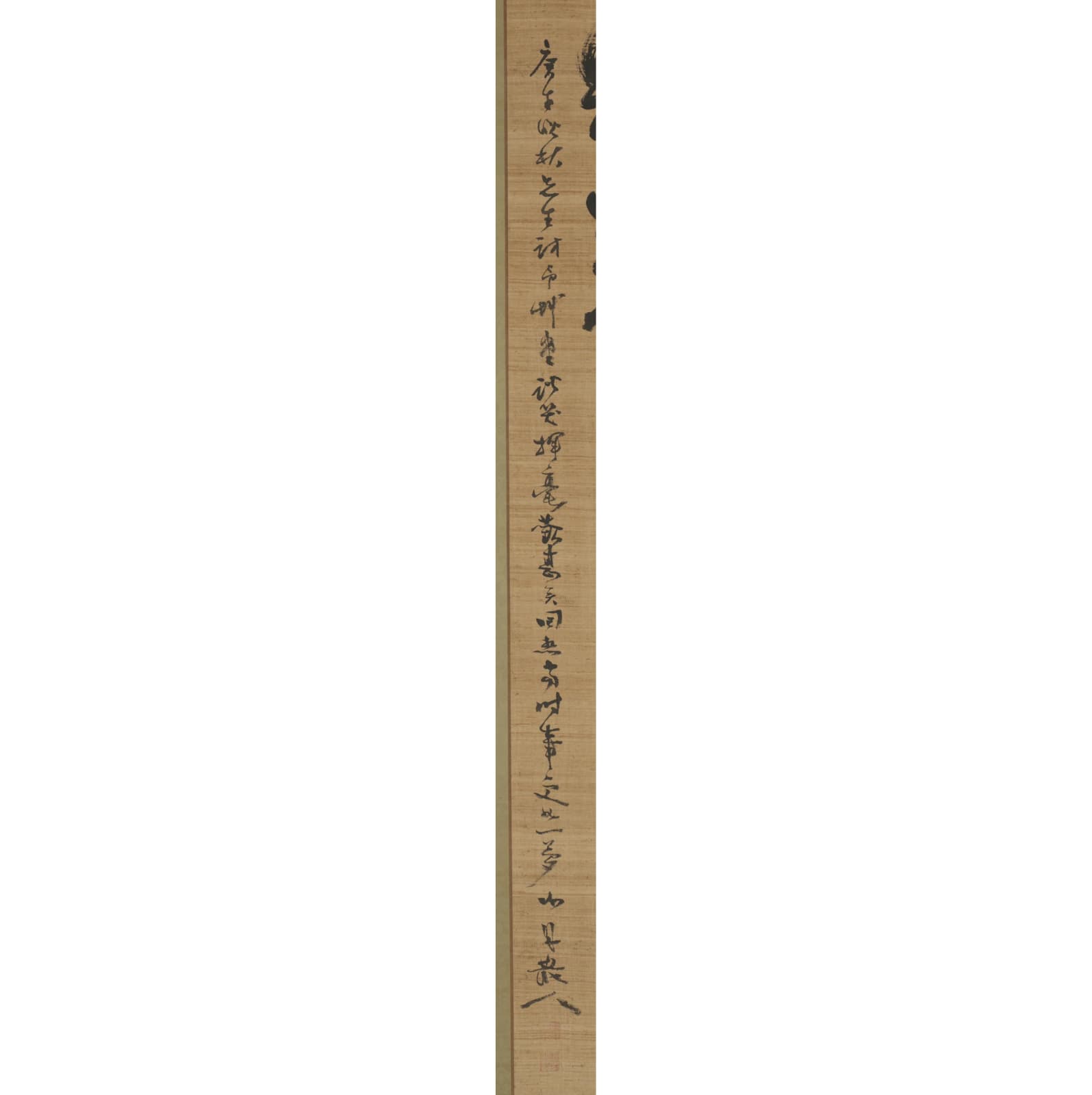Saigō Nanshū (1827−1877)
Chinese Style Poem
Ink on linen, hanging scroll
With an inscription by Katsu Kaishu
Seals: Gokuchu kakei Moko ni oyobu, To Ryusei in, Nanshu (Nanshu) ; Mononobe Yoshikuni, Na o banko ni taru shinnu nanno yozo (Kaishu)
166 x 87 cm
227 x 109 cm (overall)
With an inscription by Katsu Kaishu
Seals: Gokuchu kakei Moko ni oyobu, To Ryusei in, Nanshu (Nanshu) ; Mononobe Yoshikuni, Na o banko ni taru shinnu nanno yozo (Kaishu)
166 x 87 cm
227 x 109 cm (overall)
Further images
Provenance
Collection of the Katsu familyLiterature
Nanshu sensei ibokushu. Tokyo: Kogeisha, 1926.
The author ran a dog and climbed a hazardous mountain by himself. Feeling his spirit boosted, he composed the poem and sighed for the life journey in this world that is even more precarious than climbing a mountain. Being a fearless warrior, the author Saigo Nanshu spent an unpeaceful life, just as this poem describes.
The present work was in the possession of Katsu Kaishu, who was in long and deep connection with Saigo even after the Meiji Restoration, despite their opposing political positions. Katsu inscribes in this work: “In late autumn of 1870, Master (Saigo) came to visit me. While we were having enjoyable conversation, [Saigo] brushed this [poem] for me. There is nothing more pleasurable than this. Now when I am remembering the day, it feels like a dream.” Saigo Takamori zenshu, the collection of the complete works of Saigo, discusses the present work in volume 4 and points out that Katsu might have remembered the year wrong, as Saigo did not visit Tokyo in 1870, and the poem must be composed before the year of 1870 when Saigo was in Kagoshima. Later, in 1873, Saigo resigned from the Meiji Government for different political ideologies from Okubo Toshimichi.
It is said that Katsu had sympathy for Saigo during the Satsuma Rebellion led by Saigo in 1877. Considering this, Katsu’s word “it feels like a dream” brings up melancholic mood.
Saigo Nanshu (samurai, politician; 1827–1877)
Also known as Kokichi, Kichibe, and Kichinosuke.
Satsuma-born late Edo and early Meiji-period Satsuma domain samurai and politician. His names are Takanaga and Takamori. Leader of the anti-shogunate movements. Active at the Satsuma-Choshu alliance, conducted the coup d’etat of osei fukko (restoration of Imperial rule), and led the victorious imperial forces during the Boshin War, the civil war between the imperial court and the Tokugawa shogunate. Became a counselor in the new Meiji government, and commanded reforms such as the establishment of prefectures in place of feudal domains. Lost in the “conquer Korea debate,” resigned from the government and returned to his hometown. Later raised an army causing the Satsuma Rebellion.
The present work was in the possession of Katsu Kaishu, who was in long and deep connection with Saigo even after the Meiji Restoration, despite their opposing political positions. Katsu inscribes in this work: “In late autumn of 1870, Master (Saigo) came to visit me. While we were having enjoyable conversation, [Saigo] brushed this [poem] for me. There is nothing more pleasurable than this. Now when I am remembering the day, it feels like a dream.” Saigo Takamori zenshu, the collection of the complete works of Saigo, discusses the present work in volume 4 and points out that Katsu might have remembered the year wrong, as Saigo did not visit Tokyo in 1870, and the poem must be composed before the year of 1870 when Saigo was in Kagoshima. Later, in 1873, Saigo resigned from the Meiji Government for different political ideologies from Okubo Toshimichi.
It is said that Katsu had sympathy for Saigo during the Satsuma Rebellion led by Saigo in 1877. Considering this, Katsu’s word “it feels like a dream” brings up melancholic mood.
Saigo Nanshu (samurai, politician; 1827–1877)
Also known as Kokichi, Kichibe, and Kichinosuke.
Satsuma-born late Edo and early Meiji-period Satsuma domain samurai and politician. His names are Takanaga and Takamori. Leader of the anti-shogunate movements. Active at the Satsuma-Choshu alliance, conducted the coup d’etat of osei fukko (restoration of Imperial rule), and led the victorious imperial forces during the Boshin War, the civil war between the imperial court and the Tokugawa shogunate. Became a counselor in the new Meiji government, and commanded reforms such as the establishment of prefectures in place of feudal domains. Lost in the “conquer Korea debate,” resigned from the government and returned to his hometown. Later raised an army causing the Satsuma Rebellion.











